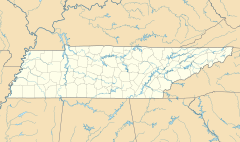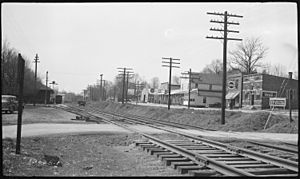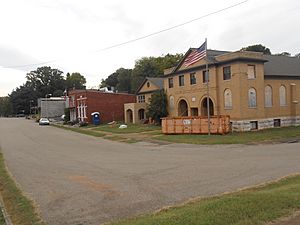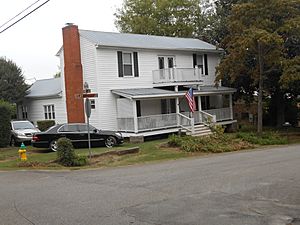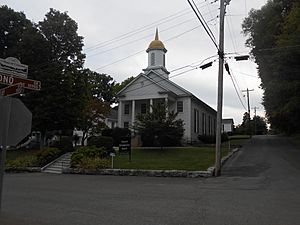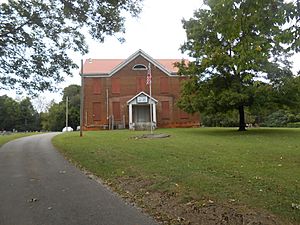Concord, Tennessee facts for kids
Quick facts for kids
Concord, Tennessee
|
|
|---|---|
 |
|
| Country | United States |
| State | Tennessee |
| County | Knox |
| Named for | Concord Presbyterian Church |
| Elevation | 850 ft (260 m) |
| Time zone | UTC-5 (Eastern (EST)) |
| • Summer (DST) | UTC-4 (EDT) |
| GNIS feature ID | 1281059 |
|
Concord Village Historic District
|
|
| Lua error in Module:Location_map at line 420: attempt to index field 'wikibase' (a nil value). | |
| Location | Roughly bounded by Lakeridge & Third Drs., Spring St., & the Masonic Hall & Cemetery, Concord, Tennessee |
|---|---|
| Area | 40 acres (16 ha) |
| Architect | Multiple |
| NRHP reference No. | 87001888 |
| Added to NRHP | October 22, 1987 |
Concord is a small, historic community in Knox County, Tennessee. It's not a city with its own government, but it's a recognized place. Concord is special because it's listed on the National Register of Historic Places. This means its old buildings and area are important to history. You can find Concord in western Knox County, between the towns of Farragut and Knoxville. Today, mail for Concord might be addressed to Concord, Knoxville, or Farragut.
Contents
History of Concord
The area that became Concord started growing in 1854. Before that, only a few people lived there. Large farms were mostly found along the Tennessee River. People living there used a nearby settlement called Campbell's Station (which is now Farragut) for trading and other needs.
How Concord Began
In 1853, something big happened: a railroad was being built along the Tennessee River. This new railroad brought more people and development to the area that would become Concord.
Concord was officially started and planned out in 1854. The land belonged to James M. Rodgers. He created 55 building lots and named the new town Concord. People believe he got the name from the nearby Concord Cumberland Presbyterian Church, where he was a member. "Concord" was a common name for churches back then.
Mr. Rodgers started selling lots in 1855. He later moved to California. Before he left, he bought more large pieces of land. Some of these lands are still part of the village today.
Growth with the Railroad
Concord grew very quickly after the railroad arrived. The first house in Concord was a boarding house built by Shadrack Callaway. He was also the first Post Master in Concord.
The combination of river travel and the new railroad made Concord a central spot. It connected several communities on the north side of the river, like Campbell's Station and Ebenezer.
During the American Civil War in 1863, soldiers camped near Concord. Supplies were taken from local farms. A church about a mile north of Concord was even taken apart. Its bricks were used to build fireplaces for the soldiers.
The railroad also created a way to trade with communities in Blount County. Towns like Friendsville and Louisville were connected to Concord by ferry. They didn't get their own railroad until the 1890s. Steamboats traveling between Chattanooga and Knoxville also stopped at Concord, connecting it to other cities.
Marble Industry and Busy Times
In the 1880s, Concord became a major center for producing Tennessee marble. Several quarries (places where stone is dug out) were located near the river. The town also became important for shipping marble. Quarries from other areas sent their marble to Concord to use its train connections.
By 1883, four marble companies were working in Concord. One company even built a mill to cut and polish marble. Sadly, none of the buildings from the marble industry are left today. Many were covered by water when Fort Loudon Lake was created.
By 1887, Concord was the second largest community in Knox County, right after Knoxville. It was a major transportation hub. Marble, crushed limestone, logs, and farm goods were loaded onto boats at its public dock. Passenger boats and commercial ships stopped there. The railroad offered train rides to Knoxville and other cities.
There was also a paved road that followed the railroad. This road connected Concord to other major roads, making it easy to travel in any weather.
Changes in the 20th Century
In the early 1900s, Concord had grown quite a bit. It had several general stores, a place to make bricks, a lime kiln, an inn, and many other businesses. There were also private schools, a bank, a post office, and churches. In 1916, a fire destroyed much of the business area, but it was quickly rebuilt.
The Great Depression in the 1930s brought tough times to Concord. New building materials meant less demand for Tennessee marble, and the marble industry declined.
Then, in 1944, a big change happened: Fort Loudon Lake was created. This flooded about one-third of the town, including most of the business district. Parts of the railroad had to be moved to higher ground. Trains still carried goods, but passenger service stopped. The rise of cars and new roads also meant Concord grew more slowly.
Concord Today
In the 1970s, Concord started to grow again. It became a "bedroom community" for Knoxville, meaning many people who worked in Knoxville chose to live in Concord. Since then, more homes have been built, and the area has become a busy community. It has changed a lot from its quiet, rural beginnings.
Images for kids


